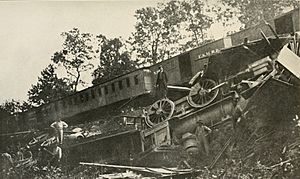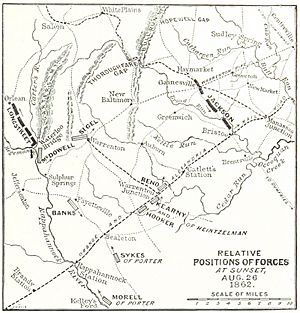Manassas Station Operations (Stonewall Jackson) facts for kids
Quick facts for kids Manassas Station Operations |
|||||||
|---|---|---|---|---|---|---|---|
| Part of the American Civil War | |||||||
 Train derailed by Confederate cavalry on August 26, 1862, during the Manassas Station Operations. |
|||||||
|
|||||||
| Belligerents | |||||||
| Commanders and leaders | |||||||
| George W. Taylor † Joseph Hooker |
Stonewall Jackson Richard S. Ewell |
||||||
| Units involved | |||||||
| Detachments, Army of Virginia | Left Wing, Army of Northern Virginia | ||||||
| Casualties and losses | |||||||
| 400-450 | 173 | ||||||
The Manassas Station Operations were a series of important events during the American Civil War. They happened from August 25 to 27, 1862, in Prince William County, Virginia. These events are also known by other names like Bristoe Station, Kettle Run, Bull Run Bridge, or Union Mills. They were a key part of the larger Northern Virginia Campaign.
On the evening of August 26, Confederate forces made a surprise move. General Stonewall Jackson led his part of the army around the right side of the Union army. They reached the Orange & Alexandria Railroad at Bristoe Station. Before dawn on August 27, Jackson's troops marched to capture and destroy a huge Union supply base. This base was located at Manassas Junction. This unexpected attack forced the Union's Army of Virginia, led by General John Pope, to quickly retreat.
On August 27, Jackson's troops defeated a Union group near Union Mills (Bull Run Bridge). This fight caused many casualties for the Union. Union General George W. Taylor was badly wounded and later died. Meanwhile, Confederate General Richard S. Ewell's division fought a strong battle against Union General Joseph Hooker's division at Kettle Run. About 600 soldiers were hurt in this fight. Ewell's troops held off the Union forces until it got dark. That night, Jackson moved his divisions north. They went to the Bull Run battlefield and set up defenses.
Contents
Why the Manassas Station Operations Happened
In the middle of August 1862, Confederate General Robert E. Lee wanted to cut off the Union Army's supplies. The Union Army of Virginia was led by General John Pope. Lee's first plan was stopped at the First Battle of Rappahannock Station. To break this standstill, Lee sent a part of his army, called the Left Wing, to move around the Union army's right side. This group was led by General Stonewall Jackson.
Jackson's plan was to go through Thoroughfare Gap. Then, he would cut the Orange and Alexandria Railroad. This railroad was a main supply line for the Union. The other part of the Confederate army, led by General James Longstreet, would keep Pope busy along the Rappahannock River. Longstreet would follow Jackson about 36 hours later. Jackson began his march very early on August 25.
The Union army saw Jackson's movement around 9 a.m. But General Pope thought Jackson was heading to the Shenandoah Valley. So, Pope focused on Longstreet's troops, who were making a show of force along the Rappahannock River. Pope's orders that day were confusing. The Union army could not attack across the river as he wanted. When Union cavalry saw Jackson coming through Thoroughfare Gap, Pope pulled his forces back. He then tried to find Jackson's army.
Key Events at Manassas Station
Jackson's troops reached Bristoe Station on the Orange and Alexandria Railroad in the afternoon of August 26. There, they destroyed two trains. They also tore up several miles of railroad tracks. Jackson then learned about a Union supply depot at Manassas Junction. This depot was a few miles to the northeast. Jackson sent a group led by Isaac R. Trimble with cavalry to capture it.
After marching all night, Trimble's group attacked. They quickly took over the small Union guard. They captured more than 300 prisoners and eight cannons. The Confederates lost only four men. When General Pope heard about the attack on Manassas Junction, he tried to send several Union groups to surround Jackson. He ordered the Army of Virginia to march northeast towards Manassas. He also ordered Union forces from Washington to move by train to Manassas.
The groups led by George W. Taylor and E. Parker Scammon started marching on the morning of August 27. Meanwhile, Jackson left General Richard S. Ewell's division at Bristoe's Station. Ewell was to watch for Union forces. Jackson moved A. P. Hill's and William B. Taliaferro's divisions to help Trimble's group.
Just as Hill's division arrived at Manassas Junction, Trimble was attacked. The 2nd New York Heavy Artillery tried to fight. But Hill's help quickly pushed them back. At this time, General Taylor arrived by train. He did not know that he was greatly outnumbered. He prepared his group for an attack. Heavy Confederate fire, especially from their cannons, caused Taylor's group to run away. Taylor himself was badly wounded and died later. Scammon's two regiments arrived and helped cover the Union retreat. The Union lost almost 450 soldiers, including over 200 prisoners. The Confederates lost only 25 men.
To the west, Ewell's division set up along Kettle Run. They were protecting Jackson's rear from Pope's forces. General Joseph Hooker's division of the Union III Corps first met Ewell's scouts around 2:30 p.m. Ewell held his position for over an hour. But Hooker then brought up his cannons. He tried to get around the Confederate line. Shortly after 4 p.m., Ewell got orders from Jackson to retreat to Manassas Junction. Ewell successfully pulled his troops back. Hooker could not chase them because the bridge across Broad Run to the north was burned. Ewell lost fewer than 150 men in the fight. Hooker lost 400 men.
What Happened Next
Jackson now knew that Pope's army was close. He decided to move north to the site of the First Battle of Bull Run. There, he could meet up with Longstreet's forces. Or, he could retreat further north if needed. Jackson let his soldiers take as many supplies as they could carry. Then, he had the rest of the supplies burned at midnight. His troops started marching north.
Pope saw the fires at Manassas Junction. But he thought it meant Jackson was in trouble. He ordered his army groups to march on Manassas from the south, east, and north. Pope knew that Longstreet was moving north towards Thoroughfare Gap. But he did not send any forces to stop Longstreet. He believed the Union army could defeat Jackson before Longstreet arrived. The defeat of Taylor's group convinced George B. McClellan, who led Union forces in Washington, not to send more help to Pope. He would only send help if they had cannons and cavalry.
See also
 In Spanish: Batalla de las Operaciones sobre la Estación de Manassas para niños
In Spanish: Batalla de las Operaciones sobre la Estación de Manassas para niños


